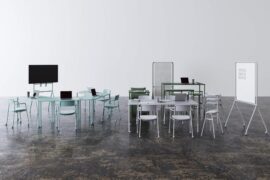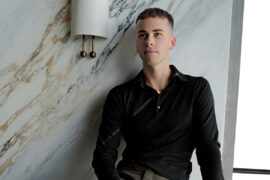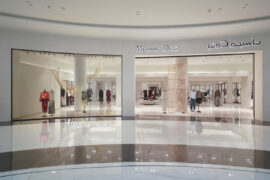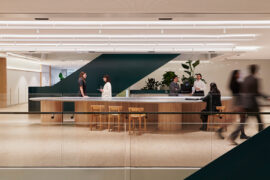Configurable in no less than 72 possible combinations, Wilkhahn’s Occo chair presents a strong design language with the flexibility of a tailored identity.
Now that we’ve been freed from the shackles of our workstations by technology, workplace designers have tried all sorts of strategies for making the office an attractive and distinct place to be. Often, suggests Burkhard Remmers, Wilkhahn’s Director of International Communication and Public Relations, this can lead to ‘collaged’ settings and the gamification of the office – aspects of workplace design that are increasingly coming under fire.
What is needed, he suggests, is a sense of identity for the workplace that doesn’t wind up infantilising workers.
One of Wilkhahn’s newest releases, the Occo chair and table range designed by jehs+laub, targets the problem of identity in the workplace with a distinct design language that simultaneously offers a broad spectrum of different looks. Occo combines enormous versatility and a vast choice of design options with a clear and immediately identifiable design language that can be used to give a consistent character to an interior environment.
The Occo chair paints a distinct figure with the cut-out plastic shell that forms its seat and backrest. The shell can be read as an ‘O’ from the front or back, and as a ‘C’ from the side, hence the name. The cut-out shape was developed from the desire to minimise the chair’s weight and to enable stacking.
While experimenting with the cut-out during the design development stage, designers Markus Jehs and Jürgen Laub found that the plastic shell gained a high degree of flexibility in the backrest. They varied the thickness of the shell to give it the desired comfort, stability and flexibility. “So then we had two functions: the flex and the stackability,” says Jehs. “These made the sculptural shape of the shell. It was pure functionalism,” he adds.
Occo was developed with a suite of options – four options for the legs, six for shell colours and three for cushioning – which altogether produce no less than 72 possible variations that can respond to all functional and design requirements.
A matching table range – with its top available in a variety of materials and shapes – further complements the collection. “We think Occo is a good answer to the identity problem,” says Remmers confidently.
INDESIGN is on instagram
Follow @indesignlive
A searchable and comprehensive guide for specifying leading products and their suppliers
Keep up to date with the latest and greatest from our industry BFF's!

Welcomed to the Australian design scene in 2024, Kokuyo is set to redefine collaboration, bringing its unique blend of colour and function to individuals and corporations, designed to be used Any Way!

For Aidan Mawhinney, the secret ingredient to Living Edge’s success “comes down to people, product and place.” As the brand celebrates a significant 25-year milestone, it’s that commitment to authentic, sustainable design – and the people behind it all – that continues to anchor its legacy.

With experience across fashion, styling and interiors, Nicholas Gilbert launches Studio Nicholas with a mission to elevate Australian design on the world stage — and to champion a more rigorous, professional future for the industry.

Crafting form and creating function with rattan, Patrick Keane and Enter Projects Asia’s latest project is proving to be a draw card for shoppers at the dynamic fashion house Massimo Dutti.
The internet never sleeps! Here's the stuff you might have missed

Richmond came alive for Saturday Indesign 2025 as showrooms, rooftops and laneways transformed into a celebration of design, creativity and connection.

Law is one of the oldest professions in the world but Architectus’ new design for Ashurst Sydney’s workplace at 39 Martin Place reflects and responds to contemporary shifts.